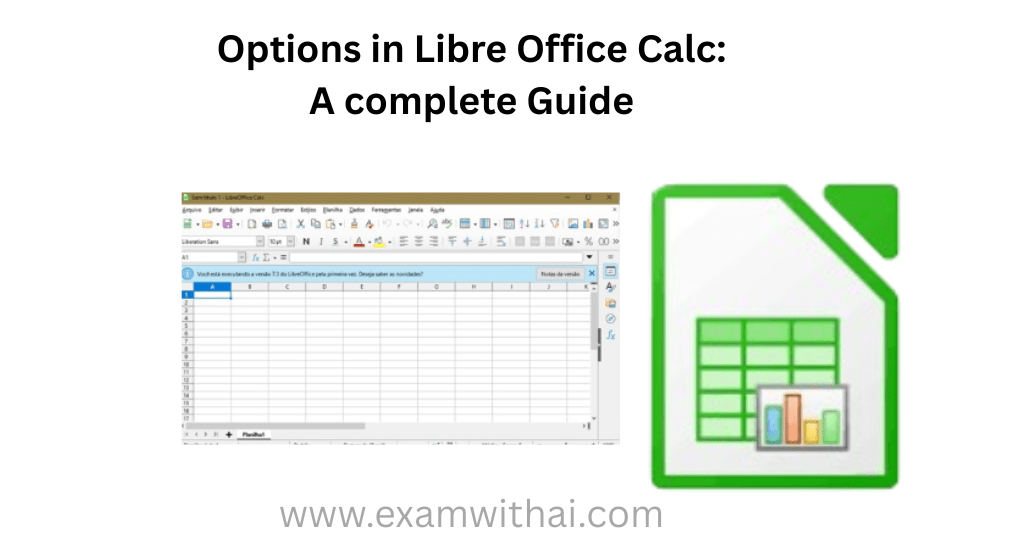LibreOffice Calc
LibreOffice Calc is a free and open-source spreadsheet program that’s part of the LibreOffice suite, which is an alternative to Microsoft Office. Calc is basically the equivalent of Microsoft Excel.

Options in LibreOffice Calc
File Menu
- Open: Open an existing spreadsheet.
- Save/Save As: You may either save your document or give it a new name.
- New: Create a new spreadsheet.
- Recent: Access spreadsheets that have recently been opened.
- Export: Export the spreadsheet to formats like PDF, HTML, or Excel.
- Print: Print your spreadsheet.
- Properties: Display document properties like title, author, and other metadata.
Edit Menu
- Undo/Redo: Reverse or undo the previous action.
- Cut/Copy/Paste: Common choices for contents, ranges, or cells.
- Find & Replace: Look for data or text, then replace it.
- Delete Cells: Select rows, columns, or cells that can be deleted.
- Insert Cells: Add additional rows, columns, or cells to the spreadsheet.
- Select All: Select the entire sheet.
- Preferences: Go to Calc’s settings and user preferences.
View Menu
- Normal: Standard view mode for data editing and manipulation.
- Page Break Preview: Display page breaks for the arrangement of printing.
- Zoom: To improve visibility, you can zoom in or out of the current spreadsheet.
- Grid: Show or hide the gridlines for the spreadsheet.
- Ruler: Display a ruler for alignment.
- Toolbars: Show or hide various toolbars (e.g., formatting, formula bar, etc.).
- Status Bar: Change the status bar’s visibility.
- Formula Bar: Show or hide the formula bar for easier formula input.
- Full Screen: Switch to full-screen mode so you can concentrate on the document.
Insert Menu
- Sheet: Insert a new sheet into the current document.
- Column/Row: Insert new rows or columns into the sheet.
- Cells: Insert specific cells (or ranges) into a sheet.
- Functions: Insert predefined functions and formulas into a cell.
- Chart: Insert a chart to visualize your data.
- Hyperlink: Add a hyperlink to a cell.
- Text Box: Insert a text box into the sheet.
- Object: Insert special objects like images, drawings, or OLE objects.
- Comment: Add comments to individual cells.
- Date and Time: Insert the current date and time into a cell.
- Picture: Insert images and graphics into a spreadsheet.
Format Menu
- Cells: Modify the cell format (font, borders, alignment, etc.).
- Rows/Columns: Row height and column width can be changed.
- Sheet:Page: Change attributes particular to a sheet, such as background, protection, or names.
- Styles and Formatting: Set up the page layout for printing, including orientation, margins, and size.
- Conditional Formatting: Apply or customize cell styles (such as currency, date, etc.).
- Cell Protection: Lock or unlock cells to prevent accidental editing when the sheet is protected.
- Borders: Customize the borders around cells or ranges.
- Alignment: Align the contents of the cells (left, right, center, etc.).
Data Menu
- Sort: Sort data by various criteria (ascending, descending) within a range of cells.
- Filter: Apply filters to data to display only specific values or conditions.
- Consolidate: Combine information from many sheets or ranges.
- Subtotals: Make subtotals using a range that has been grouped.
- Group and Outline: Group rows or columns together for easier management.
- Validity: Set data validation rules (e.g., restrict data input to certain values).
- Text to Columns: Set data validation rules (e.g., restrict data input to certain values).
- Remove Duplicates: Remove duplicate rows in a selected range.
- Named Ranges: To make referring simpler, create and maintain named ranges.
Tools Menu
- Spelling and Grammar: Check the spelling and grammar of the content in the spreadsheet.
- Options: Access the application settings to customize how Calc works.
- Macros: Record, edit, or run macros for automating repetitive tasks.
- Solver: Use the Solver tool to find optimal solutions for complex mathematical problems.
- Analysis: Data analysis tools, such as the DataPilot for creating pivot tables.
- Solver: A tool for solving optimization problems.
- Protection: Protect the entire sheet or specific cells from editing.
- Extension Manager: Manage additional extensions to enhance Calc’s functionality.





